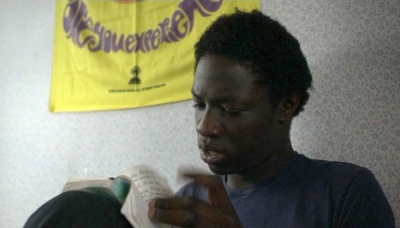Omar
Film info
Title: Omar
Running time: 9:00
Director: Sebastien Gabriel
Country of origin: France, 2010
Language: French
Genre: Live action fiction
Suggested age group: 15+
Synopsis
Omar is a young black man. The son of migrant parents; he lives in a poor area in the outskirts of Paris; an environment where he feels pressured to conceal his homosexuality. Until the day his love for Arthur is exposed and he is forced to take a decision: renounce his love or abandon his city for a new life.
Main themes
Stereotypes
Gender expectations
Personal happiness
Breaking down barriers – fighting for rights
Bullying
Homophobia
Name calling
Identity
Family
Peer relations
Feeling different
Following instinct
Cultural diversity
Violence
Coming out / outing
Objectives
- To be able to recognise the different forms of intolerance and racism in one’s own daily life and environment.
- To be able to recognise the personal motivations that lead to discriminatory actions.
- To be able to identify the importance of personal responsibility for the group or the community.
- To be able to identify constructive and communicative abilities or strategies that can effectively counter discriminatory tendencies.
Activities before the film
- Divide the students into pairs. Invite them to remember an episode of their life in which they were victims of discrimination and to think about their reactions.
- Ask the students to engage in role-play in which each of them plays both the role of the victim and the role of the aggressor in an episode of discrimination.
Afterwards, ask them to:- discuss the different feelings and thoughts they have experienced;
- think about the situation in which their emotions were more intense and why;
- think about the situation in which they identified more with the role they were laying;
- consider which feelings could lead to a change in their attitude and behaviour.
- Divide the students into groups of four. Invite them to think about aspects of themselves they might have hidden or censored for fear of being excluded or discriminated against: the fear of being different or alternative; of expressing their emotions; of telling the truth or what they truly think; of thinking different or extraordinary things, etc.
What is the role of “the different”?
Is there a secret in me I fear?
How might fears prevent me from being a complete person and an active, participative citizen?
How and why could my attitude change?
How would you describe an ideal position of inclusiveness, for you personally and for society as a whole?
- Divide the students in four groups. Invite them to think about the concepts of masculine and feminine:
- What is permissible for males that is not permissible for females and vice-versa?
- Which features does an activity/lifestyle/sport have in order to be classified as a male or female one?
- Is this same in other countries in the world?
- When your parents were young, could men and women have the same roles, same liberties they have nowadays?
Activities after the film
- Organize groups of 4-5 people in order to discuss the following points:
- How is Omar behaving with his friends?
- How does Omar react to the bullying of Arthur?
- Why does Omar go and meet Arthur in the way he does? Why is their meeting point so hidden?
- Why do Omar’s parents react in the way they do?
- How does Omar feel about being watched by his neighbour and friend, before and after being discovered?
- Ask each group to write their answers on a board
- In a plenary group, the students compare their answers and try to answer to the following question:
- What have you learned about social expectations and the freedom to be oneself?
Additional activities
Students could be asked to research stories and historical facts about discrimination against LGBT people and the LGBT movement for civil rights.
Representatives of LGBT associations could be invited to meet the class in order to discuss homophobia and their personal experiences.


